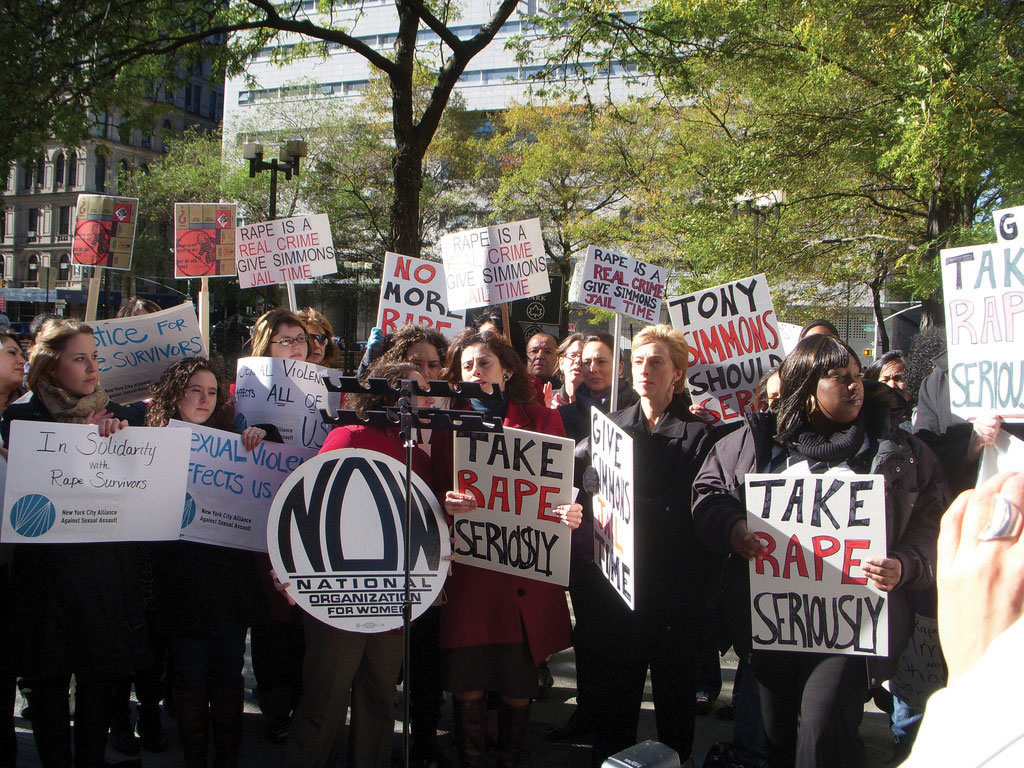This is “Understanding Social Problems”, chapter 1 from the book A Primer on Social Problems (v. 1.0). For details on it (including licensing), click here.
For more information on the source of this book, or why it is available for free, please see the project's home page. You can browse or download additional books there. To download a .zip file containing this book to use offline, simply click here.
Chapter 1 Understanding Social Problems
As we move well into the second decade of the twenty-first century, the United States and the rest of the world face many social problems: poverty and hunger, racism and sexism, drug use and violence, and climate change, to name just a few. Why do these problems exist? What are their effects? What can be done about them? This new open textbook (free online, very affordable in other formats) from a student-friendly publisher, Flat World Knowledge, tries to answer these questions with the latest theory and research from sociology and other social sciences.
The discipline of sociology began in Western Europe during the late 1800s and soon made its way to the United States. Many of the new American sociologists focused on the various social problems facing the United States at the time. This was perhaps especially true at two institutions: Atlanta University (now known as Clark Atlanta University) and the University of Chicago. Befitting their urban locations, sociologists at both universities were very interested in poverty and racial inequality, and they sought to use sociological theory and research to address these problems and, more generally, to improve society (Calhoun, 2007).Calhoun, C. (2007). Sociology in America: An introduction. In C. Calhoun (Ed.), Sociology in America: A history (pp. 1–38). Chicago, IL: University of Chicago Press.
A. Javier Treviño (2011, p. 1),Treviño, A. J. (2011). Program theme: Service sociology. Program of the 61st Annual Meeting of the Society for the Study of Social Problems, 1. Retrieved from http://www.sssp1.org/file/2011AnnualMeeting/Final%20Program.pdf. recent president of the Society for the Study of Social Problems, refers to the vision and goals of these early American sociologists as service sociology, and he emphasizes that “early American sociology was primarily a reformist endeavor.” He adds, “Service sociology is a sociology of social problems intended to ameliorate conditions of life for those in need of assistance, and to insure and promote the welfare of the community. Motivated by care and compassion, a service-oriented sociology is aimed at helping people meet their pressing social needs. As such, service sociology involves the application of sociological knowledge combined with the expression of humanitarian sentiment.”
In the spirit of early American sociology and service sociology, this book brings sociological insights to bear on the important problems of our time. Using the latest social science evidence, it discusses the dimensions and effects of various kinds of social problems, the reasons for them, and possible solutions to them.
This first chapter begins our journey into the world of social problems by examining how sociology understands social problems and gathers research about them.
1.1 What Is a Social Problem?
Learning Objectives
- Define “social problem.”
- Explain the objective and subjective components of the definition of a social problem.
- Understand the social constructionist view of social problems.
- List the stages of the natural history of social problems.
A social problemAny condition or behavior that has negative consequences for large numbers of people and that is generally recognized as a condition or behavior that needs to be addressed. is any condition or behavior that has negative consequences for large numbers of people and that is generally recognized as a condition or behavior that needs to be addressed. This definition has both an objective component and a subjective component.
The objective component is this: For any condition or behavior to be considered a social problem, it must have negative consequences for large numbers of people, as each chapter of this book discusses. How do we know if a social problem has negative consequences? Reasonable people can and do disagree on whether such consequences exist and, if so, on their extent and seriousness, but ordinarily a body of data accumulates—from work by academic researchers, government agencies, and other sources—that strongly points to extensive and serious consequences. The reasons for these consequences are often hotly debated, and sometimes, as we shall see in certain chapters in this book, sometimes the very existence of these consequences is disputed. A current example is climate change: Although the overwhelming majority of climate scientists say that climate change (changes in the earth’s climate due to the buildup of greenhouse gases in the atmosphere) is real and serious, fewer than two-thirds of Americans (64 percent) in a 2011 poll said they “think that global warming is happening” (Leiserowitz, Maibach, Roser-Renouf, & Smith, 2011).Leiserowitz, A., Maibach, E., Roser-Renouf, C., & Smith, N. (2011). Climate change in the American mind: Americans’ global warming beliefs and attitudes in May 2011. New Haven, CT: Yale Project on Climate Change Communication.
This type of dispute points to the subjective component of the definition of social problems: There must be a perception that a condition or behavior needs to be addressed for it to be considered a social problem. This component lies at the heart of the social constructionist viewThe belief that negative social conditions or behaviors do not become social problems unless citizens, policymakers, and other parties call attention to the condition or behavior and define it as a social problem. of social problems (Rubington & Weinberg, 2010).Rubington, E., & Weinberg, M. S. (2010). The study of social problems: Seven perspectives (7th ed.). New York, NY: Oxford University Press. In this view, many types of negative conditions and behaviors exist. Many of these are considered sufficiently negative to acquire the status of a social problem; some do not receive this consideration and thus do not become a social problem; and some become considered a social problem only if citizens, policymakers, or other parties call attention to the condition or behavior.

Sometimes disputes occur over whether a particular condition or behavior has negative consequences and is thus a social problem. A current example is climate change: although almost all climate scientists think climate change is real and serious, more than one-third of the American public thinks that climate change is not happening.
© Thinkstock
The history of attention given to rape and sexual assault in the United States before and after the 1970s provides an example of this latter situation. These acts of sexual violence against women have probably occurred from the beginning of humanity and certainly were very common in the United States before the 1970s. Although men were sometimes arrested and prosecuted for rape and sexual assault, sexual violence was otherwise ignored by legal policymakers and received little attention in college textbooks and the news media, and many people thought that rape and sexual assault were just something that happened (Allison & Wrightsman, 1993).Allison, J. A., & Wrightsman, L. S. (1993). Rape: The misunderstood crime. Thousand Oaks, CA: Sage Publications. Thus although sexual violence existed, it was not considered a social problem. When the contemporary women’s movement began in the late 1970s, it soon focused on rape and sexual assault as serious crimes and as manifestations of women’s inequality. Thanks to this focus, rape and sexual assault eventually entered the public consciousness, views of these crimes began to change, and legal policymakers began to give them more attention. In short, sexual violence against women became a social problem.

Before the 1970s, rape and sexual assault certainly existed and were very common, but they were generally ignored and not considered a social problem. When the contemporary women’s movement arose during the 1970s, it focused on sexual violence against women and turned this behavior into a social problem.
Image courtesy of Women’s eNews, http://www.flickr.com/photos/wenews/5167303294/.
The social constructionist view raises an interesting question: When is a social problem a social problem? According to some sociologists who adopt this view, negative conditions and behaviors are not a social problem unless they are recognized as such by policymakers, large numbers of lay citizens, or other segments of our society; these sociologists would thus say that rape and sexual assault before the 1970s were not a social problem because our society as a whole paid them little attention. Other sociologists say that negative conditions and behaviors should be considered a social problem even if they receive little or no attention; these sociologists would thus say that rape and sexual assault before the 1970s were a social problem.
This type of debate is probably akin to the age-old question: If a tree falls in a forest and no one is there to hear it, is a sound made? As such, it is not easy to answer, but it does reinforce one of the key beliefs of the social constructionist view: Perception matters at least as much as reality, and sometimes more so. In line with this belief, social constructionism emphasizes that citizens, interest groups, policymakers, and other parties often compete to influence popular perceptions of many types of conditions and behaviors. They try to influence news media coverage and popular views of the nature and extent of any negative consequences that may be occurring, the reasons underlying the condition or behavior in question, and possible solutions to the problem.

Sometimes a condition or behavior becomes a social problem even if there is little or no basis for this perception. A historical example involves women in college. During the late 1800s, medical authorities and other experts warned women not to go to college for two reasons: they feared that the stress of college would disrupt women’s menstrual cycles, and they thought that women would not do well on exams while they were menstruating.
© Thinkstock
Social constructionism’s emphasis on perception has a provocative implication: Just as a condition or behavior may not be considered a social problem even if there is strong basis for this perception, so may a condition or behavior be considered a social problem even if there is little or no basis for this perception. The “issue” of women in college provides a historical example of this latter possibility. In the late 1800s, leading physicians and medical researchers in the United States wrote journal articles, textbooks, and newspaper columns in which they warned women not to go to college. The reason? They feared that the stress of college would disrupt women’s menstrual cycles, and they also feared that women would not do well in exams during “that time of the month” (Ehrenreich & English, 2005)!Ehrenreich, B., & English, D. (2005). For her own good: Two centuries of the experts’ advice to women (2nd ed.). New York, NY: Anchor Books. We now know better, of course, but the sexist beliefs of these writers turned the idea of women going to college into a social problem and helped to reinforce restrictions by colleges and universities on the admission of women.
In a related dynamic, various parties can distort certain aspects of a social problem that does exist: politicians can give speeches, the news media can use scary headlines and heavy coverage to capture readers’ or viewers’ interest, businesses can use advertising and influence news coverage. News media coverage of violent crime provides many examples of this dynamic (Robinson, 2011; Surette, 2011).Robinson, M. B. (2011). Media coverage of crime and criminal justice. Durham, NC: Carolina Academic Press; Surette, R. (2011). Media, crime, and criminal justice: Images, realities, and policies (4th ed.). Belmont, CA: Wadsworth. The news media overdramatize violent crime, which is far less common than property crime like burglary and larceny, by featuring so many stories about it, and this coverage contributes to public fear of crime. Media stories about violent crime also tend to be more common when the accused offender is black and the victim is white and when the offender is a juvenile. This type of coverage is thought to heighten the public’s prejudice toward African Americans and to contribute to negative views about teenagers.
The Natural History of a Social Problem
We have just discussed some of the difficulties in defining a social problem and the fact that various parties often try to influence public perceptions of social problems. These issues aside, most social problems go through a natural history consisting of several stages of their development (Spector & Kitsuse, 2001).Spector, M., & Kitsuse, J. I. (2001). Constructing social problems. New Brunswick, NJ: Transaction.
Stage 1: Emergence and Claims Making
A social problem emerges when a social entity (such as a social change group, the news media, or influential politicians) begins to call attention to a condition or behavior that it perceives to be undesirable and in need of remedy. As part of this process, it tries to influence public perceptions of the problem, the reasons for it, and possible solutions to it. Because the social entity is making claims about all these matters, this aspect of Stage 1 is termed the claims-making processThe use of arguments to try to influence public perceptions of a social problem, the reasons for it, and possible solutions to it.. Not all efforts to turn a condition or behavior into a social problem succeed, and if they do not succeed, a social problem does not emerge. Because of the resources they have or do not have, some social entities are more likely than others to succeed at this stage. A few ordinary individuals have little influence in the public sphere, but masses of individuals who engage in protest or other political activity have greater ability to help a social problem emerge. Because politicians have the ear of the news media and other types of influence, their views about social problems are often very influential. Most studies of this stage of a social problem focus on the efforts of social change groups and the larger social movement to which they may belong, as most social problems begin with bottom-up efforts from such groups.

A social problem emerges when a social change group successfully calls attention to a condition or behavior that it considers serious. Protests like the one depicted here have raised the environmental consciousness of Americans and helped put pressure on businesses to be environmentally responsible.
Image courtesy of ItzaFineDay, http://www.flickr.com/photos/itzafineday/3085307050/.
Stage 2: Legitimacy
Once a social group succeeds in turning a condition or behavior into a social problem, it usually tries to persuade the government (local, state, and/or federal) to take some action—spending and policymaking—to address the problem. As part of this effort, it tries to convince the government that its claims about the problem are legitimate—that they make sense and are supported by empirical (research-based) evidence. To the extent that the group succeeds in convincing the government of the legitimacy of its claims, government action is that much more likely to occur.
Stage 3: Renewed Claims Making
Even if government action does occur, social change groups often conclude that the action is too limited in goals or scope to be able to successfully address the social problem. If they reach this conclusion, they often decide to press their demands anew. They do so by reasserting their claims and by criticizing the official response they have received from the government or other established interests, such as big businesses. This stage may involve a fair amount of tension between the social change groups and these targets of their claims.
Stage 4: Development of Alternative Strategies
Despite the renewed claims making, social change groups often conclude that the government and established interests are not responding adequately to their claims. Although the groups may continue to press their claims, they nonetheless realize that these claims may fail to win an adequate response from established interests. This realization leads them to develop their own strategies for addressing the social problem.
Key Takeaways
- The definition of a social problem has both an objective component and a subjective component. The objective component involves empirical evidence of the negative consequences of a social condition or behavior, while the subjective component involves the perception that the condition or behavior is indeed a problem that needs to be addressed.
- The social constructionist view emphasizes that a condition or behavior does not become a social problem unless there is a perception that it should be considered a social problem.
- The natural history of a social problem consists of four stages: emergence and claims making, legitimacy, renewed claims making, and alternative strategies.
For Your Review
- What do you think is the most important social problem facing our nation right now? Explain your answer.
- Do you agree with the social constructionist view that a negative social condition or behavior is not a social problem unless there is a perception that it should be considered a social problem? Why or why not?
1.2 Sociological Perspectives on Social Problems
Learning Objectives
- Define the sociological imagination.
- Explain what is meant by the blaming-the-victim belief.
- Summarize the most important beliefs and assumptions of functionalism and conflict theory.
- Summarize the most important beliefs and assumptions of symbolic interactionism and exchange theory.
The sociological understanding of social problems rests heavily on the concept of the sociological imagination. We discuss this concept in some detail before turning to various theoretical perspectives that provide a further context for understanding social problems.
The Sociological Imagination
Many individuals experience one or more social problems personally. For example, many people are poor and unemployed, many are in poor health, and many have family problems, drink too much alcohol, or commit crime. When we hear about these individuals, it is easy to think that their problems are theirs alone, and that they and other individuals with the same problems are entirely to blame for their difficulties.
Sociology takes a different approach, as it stresses that individual problems are often rooted in problems stemming from aspects of society itself. This key insight informed C. Wright Mills’s (1959)Mills, C. W. (1959). The sociological imagination. London, United Kingdom: Oxford University Press. classic distinction between personal troublesC. Wright Mills’s term for the personal problems that many individuals experience. and public issuesC. Wright Mills’s term for problems in society that underlie personal troubles.. Personal troubles refer to a problem affecting individuals that the affected individual, as well as other members of society, typically blame on the individual’s own personal and moral failings. Examples include such different problems as eating disorders, divorce, and unemployment. Public issues, whose source lies in the social structure and culture of a society, refer to social problems affecting many individuals. Problems in society thus help account for problems that individuals experience. Mills felt that many problems ordinarily considered private troubles are best understood as public issues, and he coined the term sociological imaginationFrom C. Wright Mills, the realization that personal troubles are rooted in public issues. to refer to the ability to appreciate the structural basis for individual problems.
To illustrate Mills’s viewpoint, let’s use our sociological imaginations to understand some contemporary social problems. We will start with unemployment, which Mills himself discussed. If only a few people were unemployed, Mills wrote, we could reasonably explain their unemployment by saying they were lazy, lacked good work habits, and so forth. If so, their unemployment would be their own personal trouble. But when millions of people are out of work, unemployment is best understood as a public issue because, as Mills (1959, p. 9)Mills, C. W. (1959). The sociological imagination. London, United Kingdom: Oxford University Press. put it, “the very structure of opportunities has collapsed. Both the correct statement of the problem and the range of possible solutions require us to consider the economic and political institutions of the society, and not merely the personal situation and character of a scatter of individuals.”

When only a few people are out of work, it is fair to say that their unemployment is their personal trouble. However, when millions of people are out of work, as has been true since the economic downturn began in 2008, this massive unemployment is more accurately viewed as a public issue. As such, its causes lie not in the unemployed individuals but rather in our society’s economic and social systems.
© Thinkstock
The high US unemployment rate stemming from the severe economic downturn that began in 2008 provides a telling example of the point Mills was making. Millions of people lost their jobs through no fault of their own. While some individuals are undoubtedly unemployed because they are lazy or lack good work habits, a more structural explanation focusing on lack of opportunity is needed to explain why so many people were out of work. If so, unemployment is best understood as a public issue rather than a personal trouble.
Another social problem is eating disorders. We usually consider a person’s eating disorder to be a personal trouble that stems from a lack of control, low self-esteem, or another personal problem. This explanation may be OK as far as it goes, but it does not help us understand why so many people have the personal problems that lead to eating disorders. Perhaps more important, this belief also neglects the larger social and cultural forces that help explain such disorders. For example, most Americans with eating disorders are women, not men. This gender difference forces us to ask what it is about being a woman in American society that makes eating disorders so much more common. To begin to answer this question, we need to look to the standard of beauty for women that emphasizes a slender body (Boyd, Reynolds, Tillman, & Martin, 2011).Boyd, E. M., Reynolds, J. R., Tillman, K. H., & Martin, P. Y. (2011). Adolescent girls’ race/ethnic status, identities, and drive for thinness. Social Science Research, 40(2), 667–684. If this cultural standard did not exist, far fewer American women would suffer from eating disorders than do now. Because it does exist, even if every girl and woman with an eating disorder were cured, others would take their places unless we could somehow change this standard. Viewed in this way, eating disorders are best understood as a public issue, not just as a personal trouble.
Picking up on Mills’s insights, William Ryan (1976)Ryan, W. (1976). Blaming the victim (Rev. ed.). New York, NY: Vintage Books. pointed out that Americans typically think that social problems such as poverty and unemployment stem from personal failings of the people experiencing these problems, not from structural problems in the larger society. Using Mills’s terms, Americans tend to think of social problems as personal troubles rather than public issues. As Ryan put it, they tend to believe in blaming the victimThe belief that people experiencing difficulties are to blame for these problems. rather than blaming the systemThe belief that personal difficulties stem from problems in society..
To help us understand a blaming-the-victim ideology, let’s consider why poor children in urban areas often learn very little in their schools. According to Ryan, a blaming-the-victim approach would say the children’s parents do not care about their learning, fail to teach them good study habits, and do not encourage them to take school seriously. This type of explanation, he wrote, may apply to some parents, but it ignores a much more important reason: the sad shape of America’s urban schools, which, he said, are overcrowded, decrepit structures housing old textbooks and out-of-date equipment. To improve the schooling of children in urban areas, he wrote, we must improve the schools themselves and not just try to “improve” the parents.
As this example suggests, a blaming-the-victim approach points to solutions to social problems such as poverty and illiteracy that are very different from those suggested by a more structural approach that blames the system. If we blame the victim, we would spend our limited dollars to address the personal failings of individuals who suffer from poverty, illiteracy, poor health, eating disorders, and other difficulties. If instead we blame the system, we would focus our attention on the various social conditions (decrepit schools, cultural standards of female beauty, and the like) that account for these difficulties. A sociological understanding suggests that the latter approach is ultimately needed to help us deal successfully with the social problems facing us today.
Theoretical Perspectives
Three theoretical perspectives guide sociological thinking on social problems: functionalist theory, conflict theory, and symbolic interactionist theory. These perspectives look at the same social problems, but they do so in different ways. Their views taken together offer a fuller understanding of social problems than any of the views can offer alone. Table 1.1 "Theory Snapshot" summarizes the three perspectives.
Table 1.1 Theory Snapshot
| Theoretical perspective | Major assumptions | Views of social problems |
|---|---|---|
| Functionalism | Social stability is necessary for a strong society, and adequate socialization and social integration are necessary for social stability. Society’s social institutions perform important functions to help ensure social stability. Slow social change is desirable, but rapid social change threatens social order. | Social problems weaken a society’s stability but do not reflect fundamental faults in how the society is structured. Solutions to social problems should take the form of gradual social reform rather than sudden and far-reaching change. Despite their negative effects, social problems often also serve important functions for society. |
| Conflict theory | Society is characterized by pervasive inequality based on social class, race, gender, and other factors. Far-reaching social change is needed to reduce or eliminate social inequality and to create an egalitarian society. | Social problems arise from fundamental faults in the structure of a society and both reflect and reinforce inequalities based on social class, race, gender, and other dimensions. Successful solutions to social problems must involve far-reaching change in the structure of society. |
| Symbolic interactionism | People construct their roles as they interact; they do not merely learn the roles that society has set out for them. As this interaction occurs, individuals negotiate their definitions of the situations in which they find themselves and socially construct the reality of these situations. In so doing, they rely heavily on symbols such as words and gestures to reach a shared understanding of their interaction. | Social problems arise from the interaction of individuals. People who engage in socially problematic behaviors often learn these behaviors from other people. Individuals also learn their perceptions of social problems from other people. |
Functionalism
FunctionalismThe view that social institutions are important for their contributions to social stability., also known as the functionalist theory or perspective, arose out of two great revolutions of the eighteenth and nineteenth centuries. The first was the French Revolution of 1789, whose intense violence and bloody terror shook Europe to its core. The aristocracy throughout Europe feared that revolution would spread to their own lands, and intellectuals feared that social order was crumbling.
The Industrial Revolution of the nineteenth century reinforced these concerns. Starting first in Europe and then in the United States, the Industrial Revolution led to many changes, including the rise and growth of cities as people left their farms to live near factories. As the cities grew, people lived in increasingly poor, crowded, and decrepit conditions, and crime was rampant. Here was additional evidence, if European intellectuals needed it, of the breakdown of social order.
In response, the intellectuals began to write that a strong society, as exemplified by strong social bonds and rules and effective socialization, was needed to prevent social order from disintegrating. Without a strong society and effective socialization, they warned, social order breaks down, and violence and other signs of social disorder result.
This general framework reached fruition in the writings of Émile Durkheim (1858–1917), a French scholar largely responsible for the sociological perspective, as we now know it. Adopting the conservative intellectuals’ view of the need for a strong society, Durkheim felt that human beings have desires that result in chaos unless society limits them (Durkheim, 1897/1952, p. 274).Durkheim, É. (1952). Suicide (J. Spaulding & G. Simpson, Trans.). New York, NY: Free Press. (Original work published 1897) It does so, he wrote, through two related social mechanisms: socialization and social integration. Socialization helps us learn society’s rules and the need to cooperate, as people end up generally agreeing on important norms and values, while social integration, or our ties to other people and to social institutions such as religion and the family, helps socialize us and integrate us into society and reinforce our respect for its rules.
Today’s functionalist perspective arises out of Durkheim’s work and that of other conservative intellectuals of the nineteenth century. It uses the human body as a model for understanding society. In the human body, our various organs and other body parts serve important functions for the ongoing health and stability of our body. Our eyes help us see, our ears help us hear, our heart circulates our blood, and so forth. Just as we can understand the body by describing and understanding the functions that its parts serve for its health and stability, so can we understand society by describing and understanding the functions that its parts—or, more accurately, its social institutions—serve for the ongoing health and stability of society. Thus functionalism emphasizes the importance of social institutions such as the family, religion, and education for producing a stable society.

Émile Durkheim was a founder of sociology and is largely credited with developing the functionalist perspective.
Similar to the view of the conservative intellectuals from which it grew, functionalism is skeptical of rapid social change and other major social upheaval. The analogy to the human body helps us understand this skepticism. In our bodies, any sudden, rapid change is a sign of danger to our health. If we break a bone in one of our legs, we have trouble walking; if we lose sight in both our eyes, we can no longer see. Slow changes, such as the growth of our hair and our nails, are fine and even normal, but sudden changes like those just described are obviously troublesome. By analogy, sudden and rapid changes in society and its social institutions are troublesome according to the functionalist perspective. If the human body evolved to its present form and functions because these made sense from an evolutionary perspective, so did society evolve to its present form and functions because these made sense. Any sudden change in society thus threatens its stability and future.
As these comments might suggest, functionalism views social problems as arising from society’s natural evolution. When a social problem does occur, it might threaten a society’s stability, but it does not mean that fundamental flaws in the society exist. Accordingly, gradual social reform should be all that is needed to address the social problem.
Functionalism even suggests that social problems must be functional in some ways for society, because otherwise these problems would not continue. This is certainly a controversial suggestion, but it is true that many social problems do serve important functions for our society. For example, crime is a major social problem, but it is also good for the economy because it creates hundreds of thousands of jobs in law enforcement, courts and corrections, home security, and other sectors of the economy whose major role is to deal with crime. If crime disappeared, many people would be out of work! Similarly, poverty is also a major social problem, but one function that poverty serves is that poor people do jobs that otherwise might not get done because other people would not want to do them (Gans, 1972).Gans, H. J. (1972). The positive functions of poverty. American Journal of Sociology, 78, 275–289. Like crime, poverty also provides employment for people across the nation, such as those who work in social service agencies that help poor people.
Conflict Theory
In many ways, conflict theoryThe view that society is composed of groups with different interests arising from their placement in the social structure. is the opposite of functionalism but ironically also grew out of the Industrial Revolution, thanks largely to Karl Marx (1818–1883) and his collaborator, Friedrich Engels (1820–1895). Whereas conservative intellectuals feared the mass violence resulting from industrialization, Marx and Engels deplored the conditions they felt were responsible for the mass violence and the capitalist society they felt was responsible for these conditions. Instead of fearing the breakdown of social order that mass violence represented, they felt that revolutionary violence was needed to eliminate capitalism and the poverty and misery they saw as its inevitable results (Marx, 1867/1906; Marx & Engels, 1848/1962).Marx, K. (1906). Capital. New York, NY: Random House. (Original work published 1867); Marx, K., & Engels, F. (1962). The communist manifesto. In Marx and Engels: Selected works (Vol. 2, pp. 21–65). Moscow, Russia: Foreign Language Publishing House. (Original work published 1848).
According to Marx and Engels, every society is divided into two classes based on the ownership of the means of production (tools, factories, and the like). In a capitalist society, the bourgeoisie, or ruling class, owns the means of production, while the proletariat, or working class, does not own the means of production and instead is oppressed and exploited by the bourgeoisie. This difference creates an automatic conflict of interests between the two groups. Simply put, the bourgeoisie is interested in maintaining its position at the top of society, while the proletariat’s interest lies in rising up from the bottom and overthrowing the bourgeoisie to create an egalitarian society.
In a capitalist society, Marx and Engels wrote, revolution is inevitable because of structural contradictions arising from the very nature of capitalism. Because profit is the main goal of capitalism, the bourgeoisie’s interest lies in maximizing profit. To do so, capitalists try to keep wages as low as possible and to spend as little money as possible on working conditions. This central fact of capitalism, said Marx and Engels, eventually prompts the rise of class consciousnessAwareness of one’s placement in the social structure and the interests arising from this placement., or an awareness of the reasons for their oppression, among workers. Their class consciousness in turn leads them to revolt against the bourgeoisie to eliminate the oppression and exploitation they suffer.
Marx and Engels’ view of conflict arising from unequal positions held by members of society lies at the heart of today’s conflict theory. This theory emphasizes that different groups in society have different interests stemming from their different social positions. These different interests in turn lead to different views on important social issues. Some versions of the theory root conflict in divisions based on race and ethnicity, gender, and other such differences, while other versions follow Marx and Engels in seeing conflict arising out of different positions in the economic structure. In general, however, conflict theory emphasizes that the various parts of society contribute to ongoing inequality, whereas functionalist theory, as we have seen, stresses that they contribute to the ongoing stability of society. Thus while functionalist theory emphasizes the benefits of the various parts of society for ongoing social stability, conflict theory favors social change to reduce inequality.

Karl Marx and his collaborator Friedrich Engels were intense critics of capitalism. Their work inspired the later development of conflict theory in sociology.
© Thinkstock
Feminist theoryThe view that society is filled with gender inequality characterized by women being the subordinate sex in the social, political, and economic dimensions of society. has developed in sociology and other disciplines since the 1970s and for our purposes will be considered a specific application of conflict theory. In this case, the conflict concerns gender inequality rather than the class inequality emphasized by Marx and Engels. Although many variations of feminist theory exist, they all emphasize that society is filled with gender inequality such that women are the subordinate sex in many dimensions of social, political, and economic life (Lorber, 2010).Lorber, J. (2010). Gender Inequality: Feminist Theories and Politics. New York, NY: Oxford University Press. Liberal feminists view gender inequality as arising out of gender differences in socialization, while Marxist feminists say that this inequality is a result of the rise of capitalism, which made women dependent on men for economic support. On the other hand, radical feminists view gender inequality as present in all societies, not just capitalist ones. Several chapters in this book emphasize the perspectives of feminist sociologists and other social scientists.
Conflict theory in its various forms views social problems as arising from society’s inherent inequality. Depending on which version of conflict theory is being considered, the inequality contributing to social problems is based on social class, race and ethnicity, gender, or some other dimension of society’s hierarchy. Because any of these inequalities represents a fundamental flaw in society, conflict theory assumes that fundamental social change is needed to address society’s many social problems.
Symbolic Interactionism
Symbolic interactionismA perspective in sociology that focuses on the meanings people gain from social interaction. focuses on the interaction of individuals and on how they interpret their interaction. Its roots lie in the work of early 1900s American sociologists, social psychologists, and philosophers who were interested in human consciousness and action. Herbert Blumer (1969),Blumer, H. (1969). Symbolic interactionism: Perspective and Method. Englewood Cliffs, NJ: Prentice Hall. a sociologist at the University of Chicago, built on their writings to develop symbolic interactionism, a term he coined. Drawing on Blumer’s work, symbolic interactionists feel that people do not merely learn the roles that society has set out for them; instead they construct these roles as they interact. As they interact, they negotiate their definitions of the situations in which they find themselves and socially construct the reality of these situations. In doing so, they rely heavily on symbols such as words and gestures to reach a shared understanding of their interaction.

Symbolic interactionism focuses on individuals, such as the people conversing here. Sociologists favoring this approach examine how and why individuals interact and interpret the meanings of their interaction.
© Thinkstock
An example is the familiar symbol of shaking hands. In the United States and many other societies, shaking hands is a symbol of greeting and friendship. This simple act indicates that you are a nice, polite person with whom someone should feel comfortable. To reinforce this symbol’s importance for understanding a bit of interaction, consider a situation where someone refuses to shake hands. This action is usually intended as a sign of dislike or as an insult, and the other person interprets it as such. Their understanding of the situation and subsequent interaction will be very different from those arising from the more typical shaking of hands. As the term symbolic interactionism implies, their understanding of this encounter arises from what they do when they interact and from their use and interpretation of the various symbols included in their interaction. According to symbolic interactionists, social order is possible because people learn what various symbols (such as shaking hands) mean and apply these meanings to different kinds of situations. If you visited a society where sticking your right hand out to greet someone was interpreted as a threatening gesture, you would quickly learn the value of common understandings of symbols.
Symbolic interactionism views social problems as arising from the interaction of individuals. This interaction matters in two important respects. First, socially problematic behaviors such as crime and drug use are often learned from our interaction with people who engage in these behaviors; we adopt their attitudes that justify committing these behaviors, and we learn any special techniques that might be needed to commit these behaviors. Second, we also learn our perceptions of a social problem from our interaction with other people, whose perceptions and beliefs influence our own perceptions and beliefs.
Because symbolic interactionism emphasizes the perception of social problems, it is closely aligned with the social constructionist view discussed earlier. Both perspectives emphasize the subjective nature of social problems. By doing so, they remind us that perceptions often matter at least as much as objective reality in determining whether a given condition or behavior rises to the level of a social problem and in the types of possible solutions that various parties might favor for a particular social problem.
Applying the Three Perspectives

To explain armed robbery, symbolic interactionists focus on how armed robbers decide when and where to rob a victim and on how their interactions with other criminals reinforce their own criminal tendencies.
© Thinkstock
To help you further understand the different views of these three theoretical perspectives, let’s see what they would probably say about armed robbery, a very serious form of crime, while recognizing that the three perspectives together provide a more comprehensive understanding of armed robbery than any one perspective provides by itself.
A functionalist approach might suggest that armed robbery actually serves positive functions for society, such as the job-creating function mentioned earlier for crime in general. It would still think that efforts should be made to reduce armed robbery, but it would also assume that far-reaching changes in our society would be neither wise nor necessary as part of the effort to reduce crime.
Conflict theory would take a very different approach to understanding armed robbery. It might note that most street criminals are poor and thus emphasize that armed robbery is the result of the despair and frustration of living in poverty and facing a lack of jobs and other opportunities for economic and social success. The roots of street crime, from the perspective of conflict theory, thus lie in society at least as much as they lie in the individuals committing such crime. To reduce armed robbery and other street crime, conflict theory would advocate far-reaching changes in the economic structure of society.
For its part, symbolic interactionism would focus on how armed robbers make such decisions as when and where to rob someone and on how their interactions with other criminals reinforce their own criminal tendencies. It would also investigate how victims of armed robbery behave when confronted by a robber. To reduce armed robbery, it would advocate programs that reduce the opportunities for interaction among potential criminal offenders, for example, after-school programs that keep at-risk youths busy in “conventional” activities so that they have less time to spend with youths who might help them get into trouble.
Key Takeaways
- According to C. Wright Mills, the sociological imagination involves the ability to recognize that private troubles are rooted in public issues and structural problems.
- Functionalism emphasizes the importance of social institutions for social stability and implies that far-reaching social change will be socially harmful.
- Conflict theory emphasizes social inequality and suggests that far-reaching social change is needed to achieve a just society.
- Symbolic interactionism emphasizes the social meanings and understandings that individuals derive from their social interaction.
For Your Review
- Select an example of a “private trouble” and explain how and why it may reflect a structural problem in society.
- At this point in your study of social problems, which one of the three sociological theoretical perspectives sounds most appealing to you? Why?
1.3 Continuity and Change in Social Problems
Learning Objectives
- Explain what is meant by this book’s subtitle, “Continuity and Change.”
- List the three sources of changes to social problems.
- Describe how the United States compares to other democracies regarding the seriousness of social problems.
This book’s subtitle, “Continuity and Change,” conveys a theme that will guide every chapter’s discussion. Social problems are, first of all, persistent. They have continued for decades and even centuries, and they show no sign of ending anytime soon. In view of social problems’ long history, certainty of continuing for some time to come, and serious consequences, it is easy to feel overwhelmed when reading about them, to think that little can be done about them, and even to become a bit depressed. As a result, it is easy for students to come away from social problems courses with a rather pessimistic, “doom and gloom” outlook (Johnson, 2005).Johnson, B. (2005). Overcoming “doom and gloom”: Empowering students in courses on social problems, injustice, and inequality. Teaching Sociology, 33, 44–58.

An important source of change in social problems is protest by a social change group or movement.
© Thinkstock
That is why this book stresses the second part of the subtitle, change. Although social problems are indeed persistent, it is also true that certain problems are less serious now than in the past. Change is possible. As just one of many examples, consider the conditions that workers face in the United States. As Chapter 12 "Work and the Economy" discusses, many workers today are unemployed, have low wages, or work in substandard and even dangerous workplaces. Yet they are immeasurably better off than a century ago, thanks to the US labor movement that began during the 1870s. Workers now have the eight-hour day, the minimum wage (even if many people think it is too low), the right to strike, and workplaces that are much safer than when the labor movement began. In two more examples, people of color and women have made incredible advances since the 1960s, even if, as Chapter 3 "Racial and Ethnic Inequality" and Chapter 4 "Gender Inequality" discuss, they continue to experience racial and gender inequality, respectively. To repeat: Change is possible.
How does change occur? One source of change in social problems is social science theory and research. Over the decades, theory and research in sociology and the other social sciences have pointed to the reasons for social problems, to potentially successful ways of addressing them, and to actual policies that succeeded in addressing some aspect of a social problem. Accordingly, the discussion in each chapter of this book is based on sound social science theory and research, and each chapter will present examples of how the findings from sociological and other social science research have either contributed to public policy related to the chapter’s social problem or have the potential of doing so.
The actions of individuals and groups may also make a difference. Many people have public-service jobs or volunteer in all sorts of activities involving a social problem: they assist at a food pantry, they help clean up a riverbank, and so forth. Others take on a more activist orientation by becoming involved in small social change groups or a larger social movement. Our nation is a better place today because of the labor movement, the Southern civil rights movement, the women’s movement, the gay rights movement, the environmental movement, and other efforts too numerous to mention. According to Frances Fox Piven (2006),Piven, F. F. (2006). Challenging authority: How ordinary people change America. Lanham, MD: Rowman & Littlefield. a former president of the American Sociological Association, it is through such efforts that “ordinary people change America,” as the subtitle of her book on this subject reads.
Sharing this view, anthropologist Margaret Mead once said, “Never doubt that a small group of thoughtful, committed citizens can change the world. Indeed, it is the only thing that ever has.” Change thus is not easy, but it can and does occur. Eleanor Roosevelt (1960, p. 168)Roosevelt, E. (1960). You learn by living: Eleven keys for a more fulfilling life. New York, NY: Harper & Row. recognized this when she wrote, “Surely, in the light of history, it is more intelligent to hope rather than to fear, to try rather than not to try. For one thing we know beyond all doubt: Nothing has ever been achieved by the person who says, ‘It can’t be done.’” In the optimistic spirit of these two famous women, we will see examples throughout this book of people making a difference in their jobs, volunteer activities, and involvement in social change efforts.

Many other democracies rank higher than the United States on poverty, health, and other social indicators. For this reason, the United States may have much to learn from their positive examples.
© Thinkstock
Change also occurs in social problems because policymakers (elected or appointed officials and other individuals) pass laws or enact policies that successfully address a social problem. They often do so only because of the pressure of a social movement, but sometimes they have the vision to act without such pressure. It is also true that many officials fail to take action despite the pressure of a social movement, so those who do take action should be applauded. A recent example involves the governor of New York, Andrew Cuomo, who made the legalization of same-sex marriage a top priority for his state when he took office in January 2011. After the New York state legislature narrowly approved same-sex marriage six months later, Cuomo’s advocacy was widely credited for enabling this to happen (Barbaro, 2011).Barbaro, M. (2011, June 6). Behind NY gay marriage, an unlikely mix of forces. New York Times, p. A1.
A final source of change is the lessons learned from other nations’ experiences with social problems. Sometimes these lessons for the United States are positive ones, as when another nation has tackled a social problem more successfully than the United States, and sometimes these lessons are negative ones, as when another nation has a more serious problem than the United States and/or has made mistakes in addressing this problem. The United States can learn from the good examples of some other nations, and it can also learn from the bad ones. For this reason, each chapter of this book discusses such examples. In this regard, the United States has much to learn from the experiences of other long-standing democracies like Canada, the nations of Western Europe, and Australia and New Zealand. Despite its great wealth, the United States ranks below most of its democratic peers on many social indicators, such as poverty, health, and so on (Holland, 2011; Russell, 2011).Holland, J. (2011, June 15). 9 countries that do it better: Why does Europe take better care of its people than America? AlterNet. Retrieved from http://www.alternet.org/story/151312/151319_countries_that_do_it_better%151313A_why_does_europe_take_better_care _of_its_people_than_america?page=151311; Russell, J. W. (2011). Double standard: Social policy in Europe and the United States (2nd ed.). Lanham, MD: Rowman & Littlefield. A major reason for this difference is that other democratic governments are far more proactive, in terms of attention and spending, than the US federal and state governments in helping their citizens. Because the United States has much to learn from their positive example, this book’s chapters all discuss policies that enable other democracies to address certain social problems far more successfully than the United States has addressed them.
Key Takeaways
- Social problems are persistent, but they have also changed over the years, and many social problems are less serious now than in the past.
- Three sources of change to social problems include social science research, the efforts of citizens acting alone or especially in social change groups, and the experiences of other nations.
For Your Review
- Have you participated in any volunteer or other activity involving a social problem? If so, why did you do so? If not, why have you not participated in such an effort?
- Do you share Eleanor Roosevelt’s optimism that social change is possible? Why or why not?
1.4 Doing Research on Social Problems
Learning Objectives
- List the major advantages and disadvantages of surveys, observational studies, and experiments.
- Explain why scholars who study social problems often rely on existing data.
Sound research is an essential tool for understanding the sources, dynamics, and consequences of social problems and possible solutions to them. This section briefly describes the major ways in which sociologists gather information about social problems. Table 1.2 "Major Sociological Research Methods" summarizes the advantages and disadvantages of each method.
Table 1.2 Major Sociological Research Methods
| Method | Advantages | Disadvantages |
|---|---|---|
| Survey | Many people can be included. If given to a random sample of the population, a survey’s results can be generalized to the population. | Large surveys are expensive and time consuming. Although much information is gathered, this information is relatively superficial. |
| Experiments | If random assignment is used, experiments provide fairly convincing data on cause and effect. | Because experiments do not involve random samples of the population and most often involve college students, their results cannot readily be generalized to the population. |
| Observation (field research) | Observational studies may provide rich, detailed information about the people who are observed. | Because observation studies do not involve random samples of the population, their results cannot readily be generalized to the population. |
| Existing data | Because existing data have already been gathered, the researcher does not have to spend the time and money to gather data. | The data set that is being analyzed may not contain data on all the variables in which a sociologist is interested or may contain data on variables that are not measured in ways the sociologist prefers. |
Surveys
The survey is the most common method by which sociologists gather their data. The Gallup poll is perhaps the most well-known example of a survey and, like all surveys, gathers its data with the help of a questionnaire that is given to a group of respondentsPeople who answer a questionnaire.. The Gallup poll is an example of a survey conducted by a private organization, but sociologists do their own surveys, as does the government and many organizations in addition to Gallup. Many surveys are administered to respondents who are randomly chosen and thus constitute a random sampleA subset drawn from the larger population in which every unit in the population has the same chance of being included in the subset.. In a random sample, everyone in the population (whether it be the whole US population or just the population of a state or city, all the college students in a state or city or all the students at just one college, etc.) has the same chance of being included in the survey. The beauty of a random sample is that it allows us to generalize the results of the sample to the population from which the sample comes. This means that we can be fairly sure of the behavior and attitudes of the whole US population by knowing the behavior and attitudes of just four hundred people randomly chosen from that population.
Some surveys are face-to-face surveys, in which interviewers meet with respondents to ask them questions. This type of survey can yield much information, because interviewers typically will spend at least an hour asking their questions, and a high response rateThe percentage of a sample that agrees to be included in a study, usually a survey. (the percentage of all people in the sample who agree to be interviewed), which is important to be able to generalize the survey’s results to the entire population. On the downside, this type of survey can be very expensive and time consuming to conduct.

Surveys are very useful for gathering various kinds of information relevant to social problems. Advances in technology have made telephone surveys involving random-digit dialing perhaps the most popular way of conducting a survey.
© Thinkstock
Because of these drawbacks, sociologists and other researchers have turned to telephone surveys. Most Gallup polls are conducted over the telephone. Computers do random-digit dialing, which results in a random sample of all telephone numbers being selected. Although the response rate and the number of questions asked are both lower than in face-to-face surveys (people can just hang up the phone at the outset or let their answering machine take the call), the ease and low expense of telephone surveys are making them increasingly popular. Surveys done over the Internet are also becoming more popular, as they can reach many people at very low expense. A major problem with web surveys is that their results cannot necessarily be generalized to the entire population because not everyone has access to the Internet.
Surveys are used in the study of social problems to gather information about the behavior and attitudes of people regarding one or more problems. For example, many surveys ask people about their use of alcohol, tobacco, and other drugs or about their experiences of being unemployed or in poor health. Many of the chapters in this book will present evidence gathered by surveys carried out by sociologists and other social scientists, various governmental agencies, and private research and public interest firms.
Experiments
Experiments are the primary form of research in the natural and physical sciences, but in the social sciences they are for the most part found only in psychology. Some sociologists still use experiments, however, and they remain a powerful tool of social research.
The major advantage of experiments, whether they are done in the natural and physical sciences or in the social sciences, is that the researcher can be fairly sure of a cause-and-effect relationship because of the way the experiment is set up. Although many different experimental designs exist, the typical experiment consists of an experimental groupIn an experiment, the group that experiences the experimental condition. and a control groupIn an experiment, the group that does not experience the experimental condition., with subjects randomly assigned to either group. The researcher does something to the experimental group that is not done to the control group. If the two groups differ later in some variable, then it is safe to say that the condition to which the experimental group was subjected was responsible for the difference that resulted.
Most experiments take place in the laboratory, which for psychologists may be a room with a one-way mirror, but some experiments occur in the field, or in a natural setting (field experiments). In Minneapolis, Minnesota, in the early 1980s, sociologists were involved in a much-discussed field experiment sponsored by the federal government. The researchers wanted to see whether arresting men for domestic violence made it less likely that they would commit such violence again. To test this hypothesis, the researchers had police do one of the following after arriving at the scene of a domestic dispute: They either arrested the suspect, separated him from his wife or partner for several hours, or warned him to stop but did not arrest or separate him. The researchers then determined the percentage of men in each group who committed repeated domestic violence during the next six months and found that those who were arrested had the lowest rate of recidivism, or repeat offending (Sherman & Berk, 1984).Sherman, L. W., & Berk, R. A. (1984). The specific deterrent effects of arrest for domestic assault. American Sociological Review, 49, 261–272. This finding led many jurisdictions across the United States to adopt a policy of mandatory arrest for domestic violence suspects. However, replications of the Minneapolis experiment in other cities found that arrest sometimes reduced recidivism for domestic violence but also sometimes increased it, depending on which city was being studied and on certain characteristics of the suspects, including whether they were employed at the time of their arrest (Sherman, 1992).Sherman, L. W. (1992). Policing domestic violence: Experiments and dilemmas. New York, NY: Free Press.
As the Minneapolis study suggests, perhaps the most important problem with experiments is that their results are not generalizable beyond the specific subjects studied. The subjects in most psychology experiments, for example, are college students, who obviously are not typical of average Americans: They are younger, more educated, and more likely to be middle class. Despite this problem, experiments in psychology and other social sciences have given us very valuable insights into the sources of attitudes and behavior. Scholars of social problems are increasingly using field experiments to study the effectiveness of various policies and programs aimed at addressing social problems. We will examine the results of several such experiments in the chapters ahead.
Observational Studies
Observational research, also called field research, is a staple of sociology. Sociologists have long gone into the field to observe people and social settings, and the result has been many rich descriptions and analyses of behavior in juvenile gangs, bars, urban street corners, and even whole communities.
Observational studies consist of both participant observationField research in which the researcher is an active member of the group or setting being observed. and nonparticipant observationField research in which the researcher merely observes a group or setting. Their names describe how they differ. In participant observation, the researcher is part of the group that she or he is studying, spends time with the group, and might even live with people in the group. Several classical social problems studies of this type exist, many of them involving people in urban neighborhoods (Liebow, 1967; Liebow, 1993; Whyte, 1943).Liebow, E. (1967). Tally’s corner. Boston, MA: Little, Brown; Liebow, E. (1993). Tell them who I am: The lives of homeless women. New York, NY: Free Press; Whyte, W. F. (1943). Street corner society: The social structure of an Italian slum. Chicago, IL: University of Chicago Press. In nonparticipant observation, the researcher observes a group of people but does not otherwise interact with them. If you went to your local shopping mall to observe, say, whether people walking with children looked happier than people without children, you would be engaging in nonparticipant observation.
Similar to experiments, observational studies cannot automatically be generalized to other settings or members of the population. But in many ways they provide a richer account of people’s lives than surveys do, and they remain an important method of research on social problems.
Existing Data
Sometimes sociologists do not gather their own data but instead analyze existing data that someone else has gathered. The US Census Bureau, for example, gathers data on all kinds of areas relevant to the lives of Americans, and many sociologists analyze census data on such social problems as poverty, unemployment, and illness. Sociologists interested in crime and the criminal justice system may analyze data from court records, while medical sociologists often analyze data from patient records at hospitals. Analysis of existing data such as these is called secondary data analysisThe analysis of data from existing records.. Its advantage to sociologists is that someone else has already spent the time and money to gather the data. A disadvantage is that the data set being analyzed may not contain data on all the topics in which a sociologist may be interested or may contain data on topics that are not measured in ways the sociologist might prefer.
The Scientific Method and Objectivity
This section began by stressing the need for sound research in the study of social problems. But what are the elements of sound research? At a minimum, such research should follow the rules of the scientific method. As you probably learned in high school and/or college science classes, these rules—formulating hypotheses, gathering and testing data, drawing conclusions, and so forth—help guarantee that research yields the most accurate and reliable conclusions possible.
An overriding principle of the scientific method is that research should be conducted as objectively as possible. Researchers are often passionate about their work, but they must take care not to let the findings they expect and even hope to uncover affect how they do their research. This in turn means that they must not conduct their research in a manner that helps achieve the results they expect to find. Such bias can happen unconsciously, and the scientific method helps reduce the potential for this bias as much as possible.
This potential is arguably greater in the social sciences than in the natural and physical sciences. The political views of chemists and physicists typically do not affect how an experiment is performed and how the outcome of the experiment is interpreted. In contrast, researchers in the social sciences, and perhaps particularly in sociology, often have strong feelings about the topics they are studying. Their social and political beliefs may thus influence how they perform their research on these topics and how they interpret the results of this research. Following the scientific method helps reduce this possible influence.
Key Takeaways
- The major types of research on social problems include surveys, experiments, observational studies, and the use of existing data.
- Surveys are the most common method, and the results of surveys of random samples may be generalized to the populations from which the samples come.
- Observation studies and existing data are also common methods in social problems research. Observation studies enable the gathering of rich, detailed information, but their results cannot necessarily be generalized beyond the people studied.
- Research on social problems should follow the scientific method to yield the most accurate and objective conclusions possible.
For Your Review
- Have you ever been a respondent or subject in any type of sociological or psychological research project? If so, how did it feel to be studied?
- Which type of social problems research method sounds most interesting to you? Why?
1.5 End-of-Chapter Material
Summary
- Some sociologists favor the social constructionist view that negative social conditions or behaviors are not social problems unless they are generally perceived as a social problem, but other sociologists say that these conditions and behaviors are still social problems even if they are not perceived as such.
- According to C. Wright Mills, the sociological imagination involves the ability to realize that personal troubles are rooted in problems in the larger social structure. The sociological imagination thus supports a blaming-the-system view over a blaming-the-victim view.
- Social problems have existed for decades or even centuries, but many of these have also lessened in their seriousness over time, and change in the future is indeed possible.
- Several theoretical perspectives in sociology exist. Functionalism emphasizes the functions that social institutions serve to ensure the ongoing stability of society, while conflict theory focuses on the conflict among different racial, ethnic, social class, and other groups and emphasizes how social institutions help ensure inequality. Symbolic interactionism focuses on how individuals interpret the meanings of the situations in which they find themselves.




